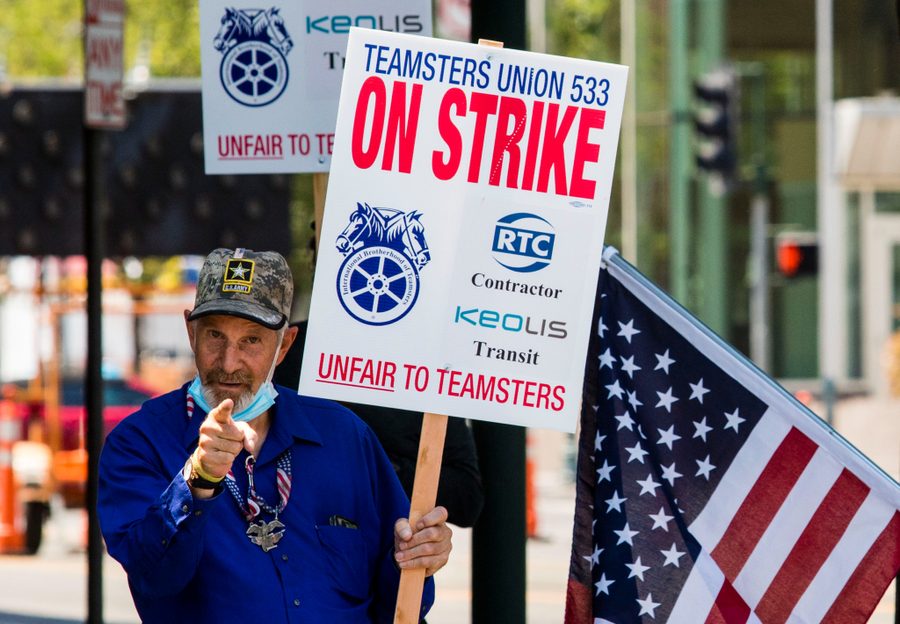Ten Predictions For the Year Ahead in Labor
Our infallible crystal ball reveals that 2022 will make workers want to holler.
Hamilton Nolan

This is the time of year when many publications are busy preparing their “Year in Review” pieces. Boring! We already lived through the past year. We know what happened. Instead, let’s look ahead to 2022 — the year that will be, probably.
One of the most valuable lessons that a journalist can learn is: Never make predictions. You will inevitably end up looking dumb. That said, here are ten predictions for the year to come in the labor movement. I feel pretty confident about these. And with any luck, none of you will remember to look back at them a year from now to check my work.
1) Higher ed becomes a serious player in the union world. The biggest new union of 2021, by far, was formed by 17,000 student researchers at the University of California, who joined the UAW. These sorts of workers, along with adjunct professors and other campus employees, now make up significant chunks of major unions like the UAW, AFSCME and many others. This organizing wave is far larger than the one in the media industry, which has drawn more attention — but both represent the well-educated but underpaid segments of the American workforce, perhaps the most fertile demographic for union organizing. Because higher ed workers are spread across many different unions, they have yet to really begin throwing their weight around as a unified force within the labor movement. But look for that to happen soon. Which will only feed into…
2) Culture wars in the union world. America’s national political discourse is in the process of descending ever deeper into the realm of bullshit culture wars, a smokescreen for the far darker and more substantive disemboweling of democracy as we know it. This is bad. Unions in general have stayed somewhat insulated from this culture warring — though fights over vaccine mandates probably fall into this category — but that simply cannot last. If unions focus their organizing on more educated and white collar workers rather than on all workers, you can bet that outside forces who despise unions will try to drive a wedge into the movement, portraying unions as elitist. This is all bullshit. Please prepare to ignore it. Meanwhile…
3) The economic situation for workers gets worse. In a weird twist for a pandemic-scarred apocalypse, 2021 was absolutely fabulous for America’s workers. Wages rose most at the lowest end of the income scale, where gains were needed most. Companies were forced to compete for labor, improving conditions across the board. Demand was high, corporate profits boomed, and workers felt safe enough to quit their jobs, or to speak out for their rights. Hope you all enjoyed that! That set of conditions will not persist. The new year will almost certainly bring higher unemployment, cooling demand, gripes over inflation, and at least a partial reversion to the mean. And on top of that…
4) The political situation gets worse, too. If you were disappointed with the relative paucity of progressive action that Democrats took while they had control of the entire federal government last year — no PRO Act, no voting rights bill, and the big social spending bill still up in the air — I have news for you: That was the high point! Democrats will likely lose control of Congress in the 2022 midterms, gridlock will descend on Washington, D.C. (more so), and any legislative promises to organized labor that the Biden administration hasn’t already fulfilled… well, don’t hold your breath. And a little more bad news…
5) No major organizing numbers. Unions talked a lot about how the pandemic would be a great organizing opportunity: Workers everywhere saw that their employers cared little for their lives, so they would be far more inclined to want to organize into unions for protection and support. That, I believe, was true. But, uh, did unions manage to organize millions of new workers — or even come up with a plausible plan to organize millions of new workers in the near future? No. No they did not. We will find, as the pandemic ebbs, that while pro-union sentiment may have risen, actual union density will have stayed stuck stubbornly in the 10% range. On the upside, though…
6) More name brand union shops. The successful Starbucks union drive in Buffalo, New York was a gleeful capstone to a long year. Contrary to some of the more breathless interpretations, it was inspiring in part because the campaign at Starbucks in Buffalo is not special — it is a demonstration of what can happen anywhere when a determined union and some determined organizers get to work. The new year will see more union drives at familiar chains, whether successful (like Starbucks) or unsuccessful (like Dollar General), as the sheer attraction of having a union pushes more retail and service workers to unions’ doorsteps, demanding to organize. Unions themselves need to prepare to cope with the demand. And speaking of name brand employers…
7) Amazon gets cracked. The RWDSU will get another chance at a union election at the Amazon warehouse in Bessemer, Alabama this year. They are statistically very unlikely to win. But the Teamsters are also at work at Amazon, and one of their organizing drives is more likely to bear fruit in the coming year. In the big picture, organizing Amazon is an absolute necessity for American unions, lest the company most in control of the future of work be totally untouchable by the power of organized labor. So we should not get too upset even if there are a string of unsuccessful union drives at Amazon for several years. Those are just steps on the path to winning. But I gotta say: 2022 feels lucky for Amazon, baby! Stay ready! And even though union votes don’t always go our way in the face of ferocious union-busting, we will certainly get…
8) More strikes. The Great Strike Wave of 2021 was perhaps driven more by the perception of tons of strikes than sheer historic numbers of striking workers, but that doesn’t really matter — there were many strikes, they got a lot of attention and many of them produced hard-fought wins. That is something the labor movement desperately needs. Strikes serve as billboards for the value of unions, and for unions’ ability to fight for change. They feed into organizing. They raise morale in unions across the country. More strikes, as hard as they are for the workers involved, are a good thing. And you can bet that after the energy the strikes of 2021 generated, you will see them continue in 2022. Get your picket line-walking shoes out. And there will be another bright spot…
9) College athlete organizing gets real. With a friendly NLRB leader paving the way, the door is now open for true labor organizing among college athletes. There are groups actively working to organize players in the most visible sports, and unions will certainly jump into the space when it begins to look promising. This should be the year that something concrete happens that will start to erase the deceiving “student athlete” trope once and for all, and replace it with “athletes who are getting paid for their work.” The potential for college athlete unions to be potent political players is huge, particularly down South. That’s good, because in general…
10) The South will be ignored. “Organize the South!” has been a rallying cry within the labor movement for damn near a century now. It still has never actually happened. Despite the fact that the South has both the need for unions and the will to organize, they lack resources — resources that can only be provided by national institutions whose attention is perpetually elsewhere. What should happen? An army of union organizers should be deployed to the South to help working people there win their fights. The bang for the buck would be astounding. What will happen? There will be occasional big union campaigns down South that will make people cry “Organize the South!” and that sentiment will be immediately forgotten when the campaigns are over. The South, like the labor movement as a whole, is still waiting for a true visionary.
Happy holidays. Happy new year. And please remember: No expert prediction bemoaning the state of the labor movement can stop you from organizing your workplace in 2022. Just do it.
Hamilton Nolan is a labor writer for In These Times. He has spent the past decade writing about labor and politics for Gawker, Splinter, The Guardian, and elsewhere. More of his work is on Substack.








